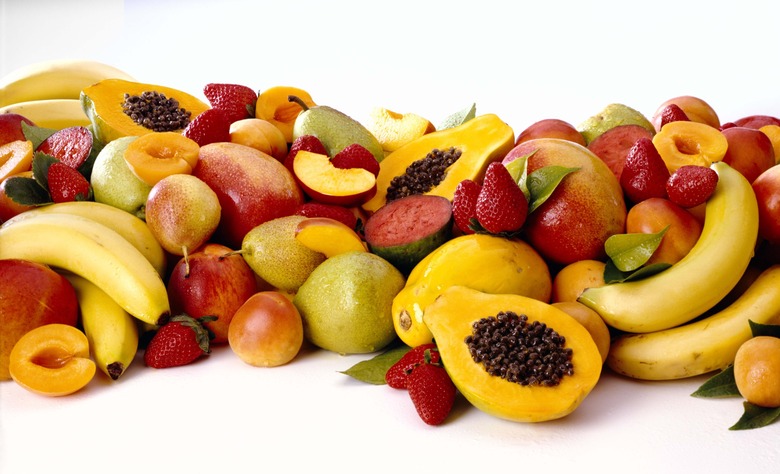Container Fruit Trees For Zone 10
If you live in one of the few frost-free areas of the country, you are fortunate to be able to grow a tremendous range of exotic fruits. In U.S. Department of Agriculture plant hardiness zone 10, the average minimum winter temperature is between 30 and 40 degrees. This means it doesn't get cold enough to grow most of the deciduous fruit trees of temperate climates, but because it rarely freezes most Mediterranean, tropical and sub-tropical fruit trees can be grown. A surprising number of these are small enough to be suitable for container growing.
Mediterranean Fruits
Step 1
Fruit trees of Mediterranean origin are adapted to mild, wet winters and hot, dry summers. These are best adapted to the areas of USDA zone 10 in California and the desert Southwest. Figs (Ficus carica) are a classic example that is hardy in USDA zones 6 through 11. All fig varieties can be grown in containers — the constriction of their roots actually causes them to produce even more fruit. Olives (Olea europea) grow in USDA zones 8 to 10. Along with figs, they are very tolerant of root restriction and tolerate heavy pruning of top growth. Olives can grow to over 30 feet tall in the ground, but can be maintained as a small tree in containers with annual pruning.
- If you live in one of the few frost-free areas of the country, you are fortunate to be able to grow a tremendous range of exotic fruits.
- Along with figs, they are very tolerant of root restriction and tolerate heavy pruning of top growth.
Subtropical Fruits
Step 1
Citrus is a large class of subtropical fruits that is easily grown in containers. Most citrus species are either naturally dwarf trees or are available in dwarf varieties. Lemons (Citrus limon), limes (Citrus aurantifolia) and tangerines (Citrus reticulata) make particularly nice patio plants, growing to only 6 or 8 feet tall in containers. They are all hardy in USDA zones 9 to 11, though tangerines can also be grown in USDA zone 8b. Another significant, but lesser known, group of small, subtropical trees are guavas. They are ornamental trees that produce small, edible fruits with a range of exotic flavors. The apple guava (Psidium guavaja) has the largest fruit of the guavas, growing up to the size of a softball, while strawberry and pineapple guavas (Acca sellowiana) are usually an inch or two in diameter. These can be grown in USDA zones 9 to 11, 9b to 10 and 8a to 11, respectively.
- Citrus is a large class of subtropical fruits that is easily grown in containers.
- The apple guava (Psidium guavaja) has the largest fruit of the guavas, growing up to the size of a softball, while strawberry and pineapple guavas (Acca sellowiana) are usually an inch or two in diameter.
Tropical Varieties
Step 1
Truly tropical fruits can be grown in USDA zone 10. Most of these are borne on large trees that are not suitable for container growing, but there are a few exceptions. Bananas (Musa spp.) make dramatic container plants with their enormous tropical leaves and huge racks of fruit. Papayas (Carica papaya) go well with bananas on a poolside patio or other tropical-themed planting. These are really tree-like more than actual trees, usually fruiting within 24 months of planting. Both require copious amounts of water and fertilizer to grow and fruit well in a container and are hardy in USDA zones 9b to 11.
- Truly tropical fruits can be grown in USDA zone 10.
- Papayas (Carica papaya) go well with bananas on a poolside patio or other tropical-themed planting.
Container Considerations
Step 1
Fruit trees need the largest possible containers to grow well and bear fruit. A 15-gallon container is generally sufficient for the first couple of years, but eventually they need to be graduated to a 25- or 30-gallon container. Any material can be used — wood, plastic and ceramic work equally well. Wine barrels that have been cut in half and converted to planters are commonly available and are ideal for the purpose. Make sure to put a 1- to 2-inch layer of gravel in the bottom of the pot to facilitate good drainage and fill it with potting soil to within 4 inches of the rim. Add a 2-inch layer of mulch to help conserve soil moisture. The remaining space at the top of the pot can be filled with water whenever the top one half of soil becomes dry to keep the trees fresh and vibrant.
- Fruit trees need the largest possible containers to grow well and bear fruit.
- The remaining space at the top of the pot can be filled with water whenever the top one half of soil becomes dry to keep the trees fresh and vibrant.
References
- USDA Agricultural Research Service: Plant Hardiness Zone Map
- Arizona State University: Common Fig
- Cal Poly Urban Forest Ecosystems Institute: Olive Tree
- Cal Poly Urban Forest Ecosystems Institute: Lemon
- Cal Poly Urban Forest Ecosystems Institute: Key Lime
- Floridata: Citrus Reticulata
- Arizona State University: Common Guava
- University of Florida Nassau County Extension : Pineapple Guava
- South-Florida-Plant-Guide.com: Strawberry Guava
